Per la tua gita al Lago Trasimeno, regalati un’escursione all’Isola Polvese, la più grande delle tre isole caratterizzano il celebre lago umbro.
Potrai esplorare la doppia anima dell’isola:
- una più naturalistica, con passeggiate nella vegetazione alla scoperta della flora e della fauna che fanno parte dello speciale ecosistema dell’isola, e con una visita al Giardino delle Piante Acquatico;
- l’altra più incentrata su storia e origini dell’isola, con esplorazioni dei suoi monumenti ed edifici, dei resti del passato che ancora oggi cela l’isola e delle testimonianze artistiche che conserva.
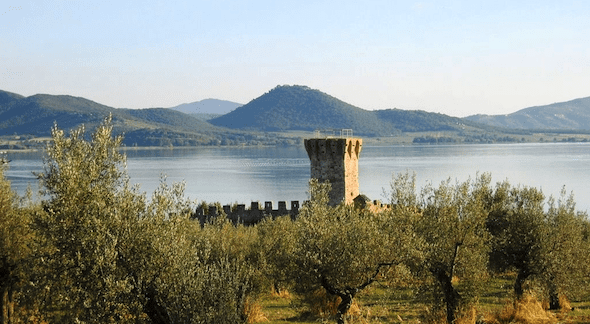
Un’escursione sull’Isola Polvese è comunque consigliata anche solo per godere dei bellissimi scorci paesaggistici e del panorama offerto dall’isola. Passeggiare a piedi nudi sulla sabbia, prendere il sole sul bagnasciuga, sorseggiare una bibita rinfrescante al tramonto con lo spettacolo delle luci rosso-arancio del sole che si specchiano nei mille riflessi blu delle acque del lago.
Un tramonto sull’isola Polvese è più di uno spettacolo per gli occhi, è un’emozione intensa da vivere.
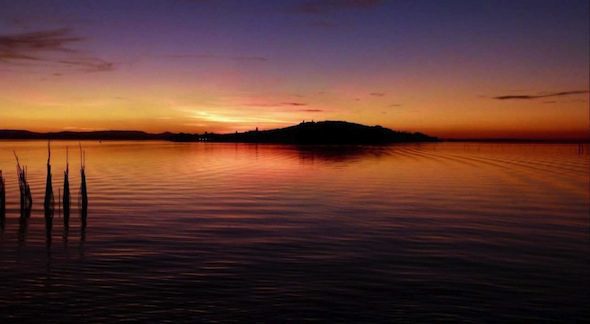
Scopri l’Isola Polvese con i nostri suggerimenti!
√ Per conoscere più da vicino le sue caratteristiche e come arrivare all’isola, leggi il nostro articolo -> Isola Polvese al Lago Trasimeno
√ Per scoprire cosa vedere sull’Isola Polvese -> continua a leggere qui sotto!
ISOLA POLVESE – ASPETTO NATURALISTICO
-
Parco Scientifico e Natura
L’area naturale dell’isola ti permetterà vivere un’esperienza completa a contatto con la natura. Qui ha sede infatti un Parco Scientifico Didattico e un Laboratorio Territoriale per lo Sviluppo Sostenibile dedicato a ricerca, educazione e turismo ambientale. Il centro propone varie visite guidate naturalistiche con percorsi tematici e attività per bambini o scuole.
Nei suoi 70 ettari di estensione, l’isola ospita un esteso canneto, l’ombrosa lecceta di San Leonardo ed un oliveto secolare. Prenditi del tempo per camminare al riparo di questi alberi, nella tranquillità dell’isola, le acque del lago che fanno capolino dalle fronde con i loro colori e riflessi.
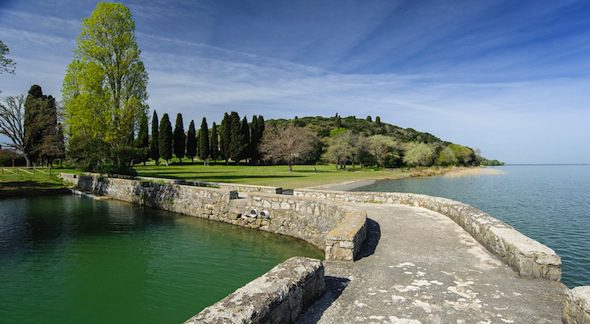
-
Il Giardino delle Piante Acquatico
Di particolare interesse, inoltre, il Giardino delle Piante Acquatico o Piscina del Porcinai, dal nome del noto architetto italiano del paesaggio Pietro Porcinai che curò il progetto. Il Giardino, commissionato dal conte Citterio proprietario dell’isola, du progettato alla fine degli anni ’50 e recuperato poi nel 1995 dopo intensi lavori di ristrutturazione.
La piscina venne creata in una cava di arenaria dismessa, interamente scavata nella roccia fino ad una profondità massima di 5,30 metri. La vasca centrale è coronata da numerosi “ninfei”, vasche minori laterali poste a diverse altezze. Sia la vasca centrale sia le piccole piscine sono alimentate direttamente dalle acque del Trasimeno, in un sistema di spazi e quote d’acqua appositamente creato dal Porcinai per dare l’illusione della continuità con le acque del lago a chi si fosse immerso nella piscina.
Nei Ninfei furono sistemate varie specie di piante acquatiche ed è quindi possibile ammirare iris selvatici, ninfee, fiori di loto, gigli d’acqua e papiri.
Il giardino è perfettamente integrato alle vasche, s’incastona in parte nella viva roccia e presenta piante tipiche della vegetazione mediterranea come mirto, corbezzolo, timo e lavanda. Tutt’attorno, in un vasto prato disseminato di alberi di ulivo, sono stati sistemati dei grandi lastroni di pietra chiamati “stenditoi” messi lì proprio per poter prendere comodamente il sole dalla piscina.
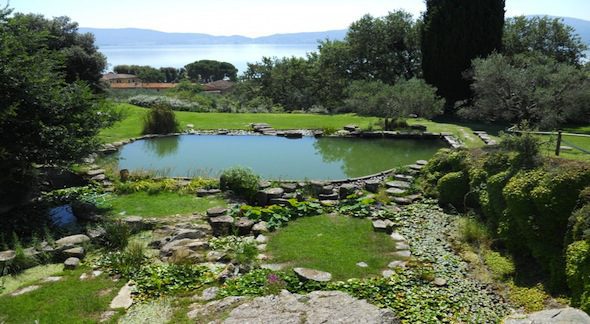
ISOLA POLVESE: ASPETTO STORICO-ARTISTICO
-
Resti del Castello Medievale
Eretto in origine nel XIV secolo, il castello costituiva una fortezza in grado di assicurare rifugio agli abitanti dell’isola in caso di attacco o pericolo (si narra che nel 1300 sull’isola abitassero circa 500 persone). Nato per difendere la popolazione e i monaci olivetani di San Secondo – vedi sotto – , il castello fu poi sede del governatore del lago. Dal 1973 la rocca, così come tutta l’isola, passarono sotto l’amministrazione di Perugia.
Oggi ne rimane la cinta muraria esterna, dalla particolare forma di un pentagono irregolare, coronata da ben 5 torri nei punti di vertice, più una sesta indipendente posta nel punto dell’antico ingresso. Le torri sono unite dalle mura attraverso un camminamento praticabile, sebbene l’interno della Rocca sia normalmente chiuso al pubblico.
Giunto sull’isola, potrai respirare l’atmosfera del passato e ammirare torri, mura medievali e il cortile interno, adibito a teatro all’aperto.
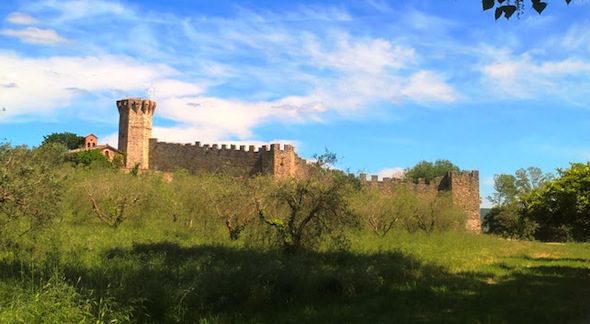
-
Chiesa di San Giuliano
La Chiesa è una vera e propria perla dell’isola. La piccola chiesa di San Giuliano infatti, costituita da una sola navata, al suo interno è affrescata e contiene porzioni di costruzione in opus reticulatum romano. Questi resti, cubilia di cm 8 di lato circa, sono conservati nel muro di terrazzamento del piazzale della chiesa.
Gli affreschi sono invece situati nelle pareti absidali e risalgono alla scuola umbra quattrocentesca. Raffigurano figure di Santi (San Giuliano, San Sebastiano, San Bernardino, San Rocco) ed altre figure purtroppo non identificate.
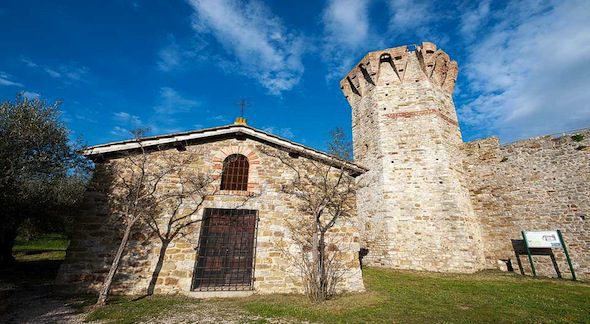
-
Complesso del Monastero di San Secondo
Le primissime notizie di questo antico complesso risalgono all’anno Mille, anche se l’effettiva elevazione a monastero riconosciuto è datata tra il XIV e il XV secolo. Dopo un periodo florido e di sviluppo iniziò la decadenza del luogo, anche per le condizioni insalubri dell’isola che furono provocate da un abbassamento delle acque del lago e un impaludimento della zona, costringendo i monaci a trasferirsi presso Perugia.
Successivamente il monastero venne chiuso in via definitiva ed infine, conseguentemente allo spopolamento e alle vicende di tutta l’isola che divenne proprietà privata, abbandonato. Dopo il ritorno all’amministrazione pubblica di Perugia, nel 1974, furono avviati lavori di restauro del complesso monumentale che è a tutt’oggi costituito da chiesa, torre campanaria e monastero.
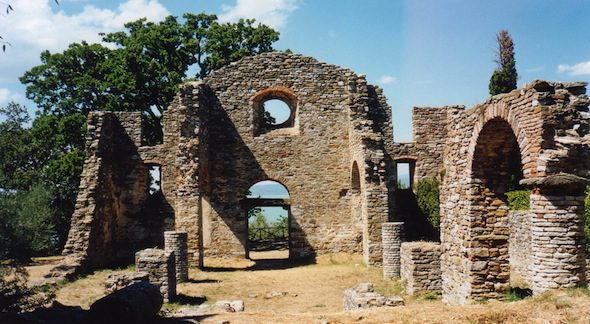
– Chiesa di San Secondo
Dell’originario edificio romano realizzato in arenaria e travertino restano oggi la facciata, i muri perimetrali esterni, una parte dell’abside e la cripta. L’ingresso alla cripta si trova in un passaggio centrale dell’abside, che scende verso il basso e si apre su un ambiente semicircolare dominato al centro da una colonna in pietra calcarea.
– Torre Campanaria
Costruita su di un’antica muratura etrusca, la torre possiede una base quadrata. E’ situata all’esterno della chiesa, nell’angolo nord orientale.
– Monastero degli Olivetani
Il complesso ha subito profonde modifiche nel corso del tempo, rendendo l’aspetto originario riconoscibile solo in parte. L’edificio è composto da due piani posti in modo perpendicolare alla chiesa, e per accedere al piano superiore occorre utilizzare i due ingressi esterni. Il piano terra costituiva la zona servizi e il refettorio, coperto da una volta a botte e caratterizzata da una grande nicchia dove era posta una statua raffigurante la Madonna. Il piano superiore, che si presenta oggi come un unico ambiente, era in passato suddiviso in più vani e fungeva da sagrestia e dormitorio per i monaci.
L’intero complesso, recuperato e consolidato con utilizzo dei materiali originari e secondo criteri conformi ai principi dell’architettura bioecologica, è stato recentemente inaugurato e ospiterà un centro di ricerca sulla qualità ambientale.
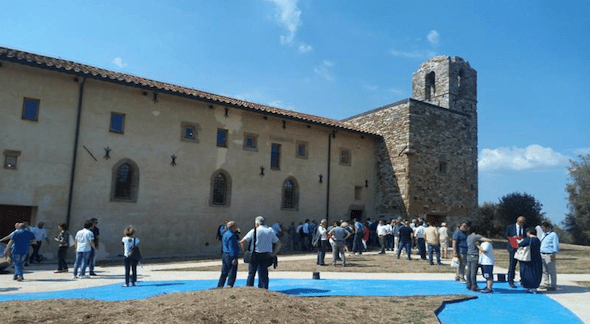
Segui i nostri suggerimenti per scoprire tutto quello che di più bello puoi vedere…
… e vivi il Trasimeno!
- Il Museo della Pesca di San Feliciano, per approfondire la vita e il lavoro dei pescatori del Trasimeno prima di imbarcarti sul traghetto per l’isola dal molo di San Feliciano
- Cosa vedere sull’Isola Maggiore, per non perdere l’altra magnifica isola del Trasimeno
- Passignano sul Trasimeno, Castiglione del Lago, e Tuoro sul Trasimeno: 3 borghi storici allungati lungo le rive del lago tutti da scoprire
- Cosa vedere al Lago Trasimeno per organizzare al meglio la tua vacanza al lago


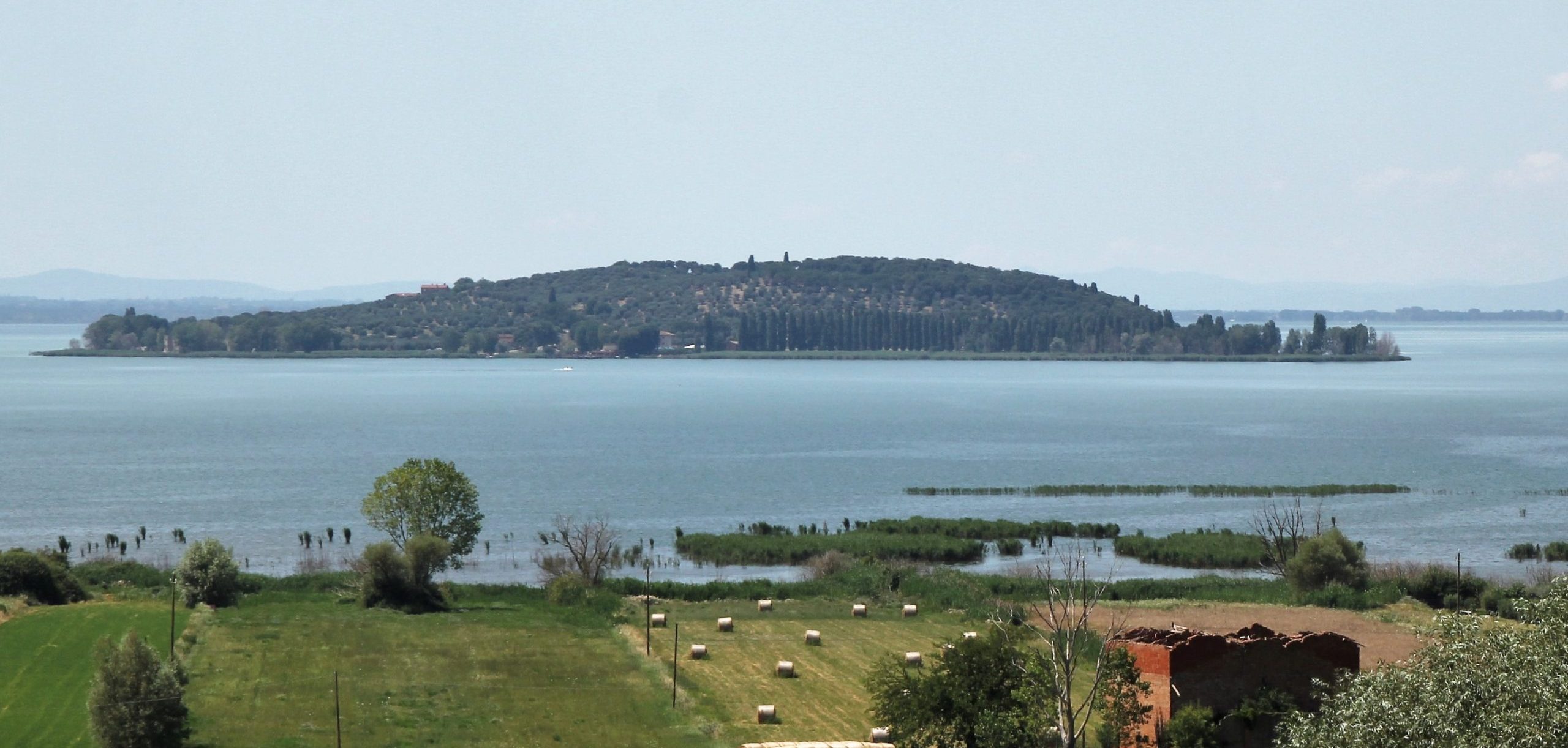
Comment (0)